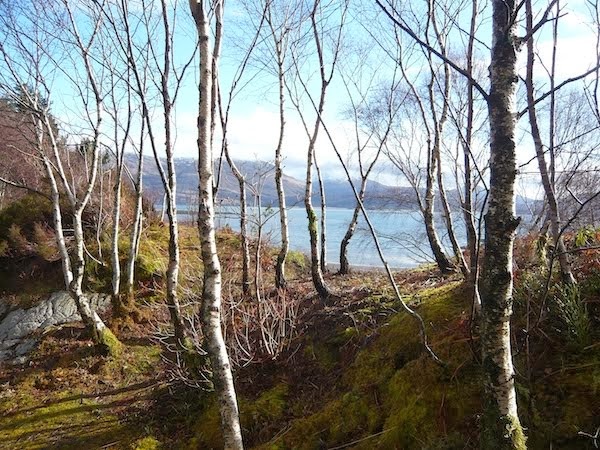I wrote this short piece some time ago (it must have been a year ago as I approach my fifty eighth birthday) and was reminded of it this afternoon as I walked to the top of the garden, sat on a bench and looked down Loch Linnhe and realised that it is the season of change. The winter pallet of subtle colour is replaced by a crescendo of growth that is so amplified when you live in the north. Five months of warmth, green and the buzz of bees before the first autumn colour will appear. From the washed out muteness of pale naples yellow and indian red, in a month or less, we will be assailed with greens of every shade, sprinkled with the stars of flower colour like hundreds and thousands on a cake, or more poetically, the stars in the sky. At last we have seen the stars in the last week or two, and more recently have been blessed with a huge golden moon. What a change from the endless grey and cloud cover we have had since November……much the same all over Britain I believe but stretching even the Highland lover we both are, to the limit none the less. But before the winter fades into spring and then the summer, I want to tell you about moss.
The colours found in moss are the strongest to be found during the winter months, and instead of walking past the miniature plants, more gripped by the larger forms of hill and tree, they become jewel like as if the detail of a medieval tapestry and you half expect a unicorn to trot into view.
In Love with Moss
As a
child I spent almost every school holiday at my grandmothers house in Scotland.
There was an enormous garden. So enormous, in fact, that the fence was said to
be two miles long. A
garden of that size is really a wilderness where in parts it is more cultivated
than others. But the site and the trees and the planting by successive
generations, not just of my family but by previous owners too, gives it a very
established feeling. In places it is entirely natural and wild.
From quite a young age I spent much time in the
garden, and as the eldest of five children, almost invariably alone but close
enough to adults and “home” for it to be considered safe. Gradually, by
degrees, I found a place that felt entirely sympathetic, safe and comfortable.
It was at the foot of an oak tree where a small stream dropped by a number of
miniature cascades down the slope between mossy banks and roots. I don’t
believe that I had read The Borrowers or that anyone had read them to me.
Indeed, I have a faint memory of finding the idea rather spooky and
frightening! So, maybe, my idea borrowed nothing from them although it is
clearly a universal one!
I remember lying on the ground, gazing at the
trickle of water that dropped through the moss and stones, imagining myself to
be small enough for the miniature cliffs and caves to be my whole world and
everything lined with the indefinable green of moss, still to this day the most
elusive and irresistible colour. The pebbles, wet in the stream bed, glistened
and became enticing jewels of granite, quartz or mica just as they still do
when walking on the beach. Without much imagination this became my “Fairy Land”
and I longed to shrink to such tiny proportions that I could live there amongst
the soft green colour. It is hard now to remember how I thought it would work. The
gift of childhood enables fantasy and play rather like playing with a dolls
house. But a house is an imitation of adult lives. I never played with a dolls
house and don’t think I either had or wanted one but I dreamt of living
outside, small enough to find shelter and warmth in all that olive green velvet
that the moss became.
Now I am about to be fifty-seven in 2013 and
after a life of vicissitudes, I am again in the Highlands. This time involved
in the making of a garden myself. And the garden we tend faces towards the
north with views of Ben Nevis glowering in the distance. There could not be a
better environment in which to grow moss. And so I have come full circle and
garden with a hand brush, sweeping old leaves and dead grass away from my
tapestry of green where the need for other plants often feels superfluous.
































